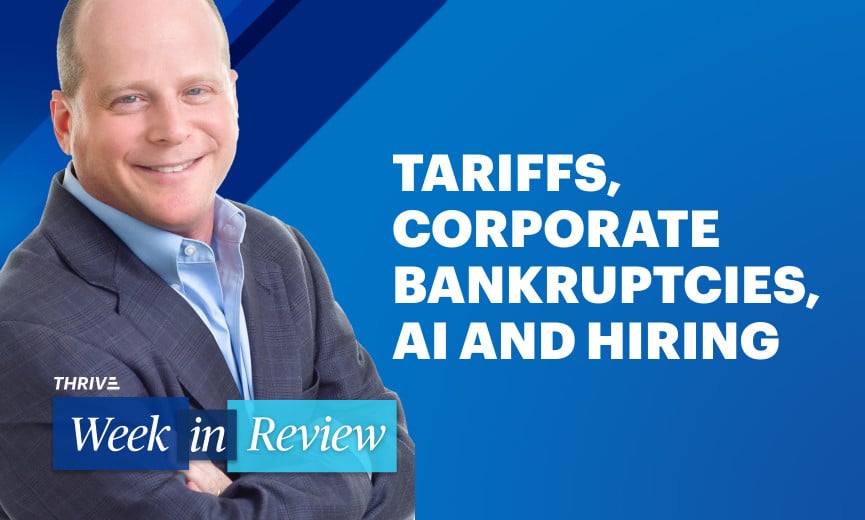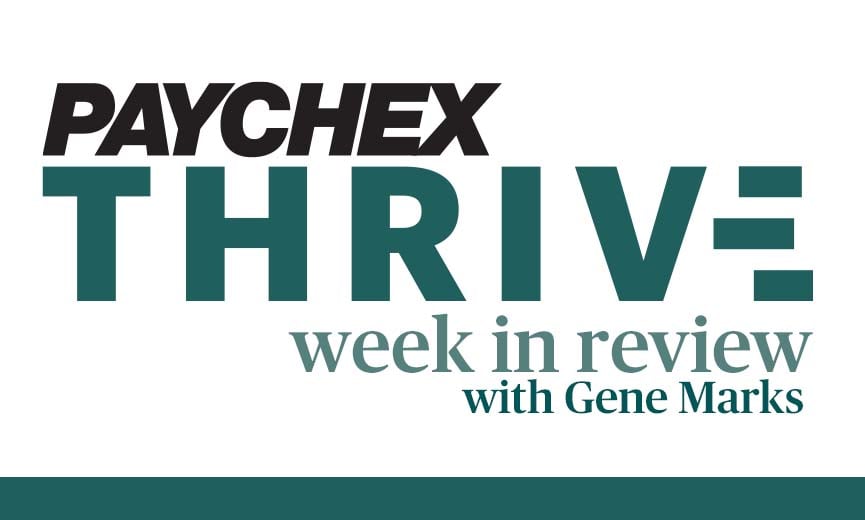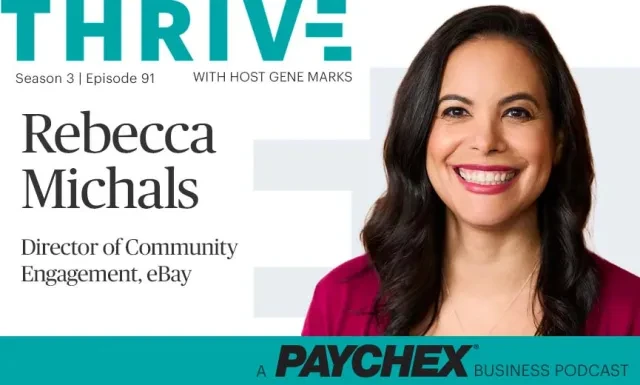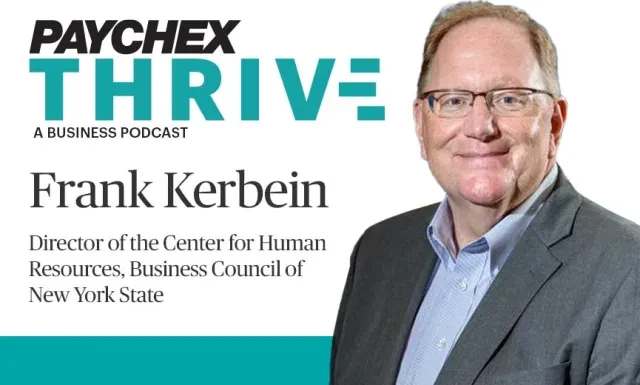Tariffs Today and Tomorrow, Corporate Bankruptcies Up, AI and Hiring

Podcast •

Vea
Resumen
Businesses struggling to keep up with tariffs and the impact should listen to this episode as host Gene Marks lays out an update and provides insights on what might be coming. He also says the recent increase in corporate bankruptcies to a 15-year high could tell us a lot about where the economy is, especially considering what industry is seeing the largest increase. And Gene doesn’t agree with how the Shopify CEO made public his thoughts on AI and hiring because of its potential impact on recruiting.
Recursos adicionales
Tariffs: What Businesses Should Know and How Can They Prepare?
Ver transcripción
Hey, everybody, it's Gene Marks and welcome to this week's episode of the Paychex THRIVE Week in Review, where we take a few items in the news that impacts your business and mine and we talk about it a little bit. So, let's get to it with you, shall we?
I mean, first of all, obviously the big news this past week has been all about tariffs, and I thought this might be a good opportunity for me to just make sure that you know what's in effect and what's not in effect. Like, with all the changes and everything that's been going on, you know, what do we need to know?
So, let me just make sure that we're clear on this. First of all, in 2024, President Biden at the time passed a bunch of tariffs on China. Those tariffs are still in effect. Tariffs of 25% on steel and aluminum coming from China, semiconductors at 50%, electric vehicles are being tariffed at 100%, critical minerals 25%, solar cells 50%, ship-to-shore cranes 25%. All of those tariffs are in effect.
In addition, President Trump has added to these tariffs with an across-the-board Chinese tariff which is also still in effect. Those tariffs are at a minimum 125% of the cost of goods coming in, and they can range as high as 185% if you figure in some of Biden's tariffs.
So, if you're doing business, with the Chinese or in China, you're buying products from China, you're selling in China, you have operations in China, you've got some issues and some things you're going to be dealing with because I think this is going to go on for a while. And I'm sure we will be revisiting this in the future.
Other than China, there were a bunch of tariffs on more than 100 countries, reciprocal tariffs that Trump proposed back on April 2. They're on hold right now, while at least 75 of those countries are renegotiating their tariff arrangements with the United States.
In addition, the president also has on hold a 20% tariff to the EU, 24% tariffs to Japan, and 25% tariffs to Mexico and Canada for any goods that are non-USMCA compliant. You know, outside the agreement – the North American Trade Agreement – that we had from back in 2020.
So, just to make sure that you're clear on this: The reciprocal tariffs, the EU tariffs, the Japanese tariffs the Mexican and Canada tariffs, they're all on pause right now for the next 90 days. However, what's still in effect is the 10% tariff on all goods the United States.
So, let me just summarize this as the smoke clears. We have a 10% tariff on all goods coming to the United States is in effect. We have up to 185% tariffs on goods coming in from China. And be aware, there are other tariffs on specific products like autos and auto parts, steel and aluminum across the board, also that come into the United States, they are still in effect, as well.
So, bottom line, some of these tariffs are still in effect a 10% overall tariff. The Chinese tariffs absolutely are still in effect tariffs on steel and aluminum tariffs on autos and auto parts. All still in effect. Everything else right now is on hold, at least for the next 90 days and we're going to see where things shake out.
So, expect a lot of disruption, a lot of uncertainty, and a lot of fluctuations in the stock market over the next few months. That is just a fact.
All right, let's move on from tariffs and let's talk about bankruptcies. According to Fox News, a new report shows that corporate bankruptcies among U.S. companies increased in the first quarter to their highest level since 2010. S&P Global Market Intelligence reported that from January through March, there were 188 bankruptcies filed among U.S. companies, an increase from 139 bankruptcies in the first quarter of 2024, which was a 14-year high at the time.
What's more concerning to me than that – I mean, it's 188 companies; you know, there's 33 million businesses in the country, and by the way, a lot of small businesses shut their doors without filing bankruptcy. So, you have to kind of take that number with a grain of salt.
What I do think is interesting that we should all be following is bankruptcies among trucking and logistics companies. According to freightwaves.com, there are a number of trucking and logistics companies bankruptcies that are being reported across the United States. I just think that you should be aware that a lot of these are there.
You know, individual firms across the, you know, across the U.S., and that particularly the Midwest have reported these bankruptcies. There's an Illinois company that just laid off 250 drivers. Other automakers of trucks laid off 900 workers due to tariffs. Thousands of more layoffs incurred during the freight industry during the first quarter.
The shipping logistics industry is definitely, you know, having some, some upheaval. Is that an indication of a slowing economy? It could be. My recommendation is you follow freightwaves.com. If you look under their layoffs and bankruptcy section, you can really get a running, total of where those are going. I think it's very interesting metrics to follow to make sure you're keeping track on that because if logistics and freight companies are doing poorly, I think that's a broader indication of the overall economy.
Finally, Shopify, the, you know, e-commerce firm that so many of my clients and so many small businesses use to set up and sell goods over, you know, online, they made an interesting announcement this week. It actually came from their chief, their CEO, Toby Littke or Lutke.
Mr. Lutke announced publicly that the company will be doing no new hires unless AI can't do the job. So, he is publicly stating that the company is not going to be doing that.
This is according to the Wall Street Journal, Shopify mandates AI integration into all its workflows internally, requiring managers to justify new hires based on AI’s inability to perform the task. AI-related job postings are on the rise as tech companies give priority to AI development and companies seeking skilled workers in the field. And the Wall Street Journal says that Shopify's AI-first approach includes performance reviews that assess employee usage of AI applications, emphasizing the importance of AI adoption.
I have two comments on this. The first is this is inevitable as AI takes over a lot of work of employees, and it's really not a bad idea for many of us as business owners, before we make that hire, to really question whether or not that the work can't be done by technology or even an investment in technology before bringing on that new person.
It's a reasonable question to ask, and I think where that's going to expand is whether or not we need existing employees if technology can replace them. I know that's not great news for the workforce, but if we're seeing, you know, CEOs at this level do this, I think it is, really an indication that AI is really playing a big part in their management decisions. So, that's my first comment.
My second comment on, Mr. Lutke's announcement is I wouldn't recommend doing something like that. I wouldn't recommend making an announcement like that. A public announcement like this has gotten a lot of news and a lot of media; Wall Street Journal has covered it, as well as a lot of other outlets, as well. Kind of makes it harder for Shopify to recruit talent, or even to retain their existing talent if the CEO of the company is so eager to replace people with AI solutions. I mean, what does that say for their workforce? What does that say for the culture?
I'm not saying he's right or wrong. I mean, I think, you know, time will play itself out and we'll see. But I don't know. I don't think it's a great move. I think that if you are looking to either cut back on your hiring or even replace existing employees with AI or technology, I think that's an internal management decision and an internal strategy. I'm not really sure I see the need for sharing that with the general public.
But again, you know, to each his own.
My name is Gene Marks, and you have watched this week's episode of the Week in Review, a Paychex THRIVE podcast. If you enjoyed this and you would like other information and advice to help you run your business, please sign up for our Paychex THRIVE newsletter. Go to paychex.com/thrive and that will help you, plus and we'll give you some back episodes of this podcast.
Thanks so much for watching. We will see you again next week. Take care.
Do you have a topic or a guest you’d like to hear on THRIVE. Visit payx.me/thrivetopics and send us your ideas or matters of interest. Also, if your business is looking to simplify your HR, payroll, benefits or insurance services, see how Paychex can help. Visit the resource hub at paychex.com/worx. That’s W-O-R-X. Paychex can help manage those complexities while you focus on all the ways you want your business to thrive.
I'm your host, Gene Marks, and thanks for joining us.
This podcast is property of Paychex, Incorporated 2025. All rights reserved.

 Apple Podcast
Apple Podcast Spotify
Spotify iHeartRadio
iHeartRadio









